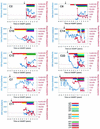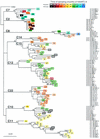Persistence of wild-type virus and lack of temporal structure in the latent reservoir for human immunodeficiency virus type 1 in pediatric patients with extensive antiretroviral exposure
- PMID: 12186930
- PMCID: PMC136462
- DOI: 10.1128/jvi.76.18.9481-9492.2002
Persistence of wild-type virus and lack of temporal structure in the latent reservoir for human immunodeficiency virus type 1 in pediatric patients with extensive antiretroviral exposure
Abstract
Although highly active antiretroviral therapy (HAART) for human immunodeficiency virus type 1 (HIV-1) infection can reduce levels of HIV-1 RNA in plasma to below the limit of detection, replication-competent forms of the virus persist in all infected individuals. One form of persistence involves a stable reservoir of latent but potentially infectious virus that resides in resting memory CD4(+) T cells. The mechanisms involved in maintaining this latent reservoir are incompletely understood. In the present study, we examined the dynamic characteristics of this reservoir in a cohort of children who developed drug-resistant HIV-1 as a result of extensive exposure to inadequately suppressive one- or two-drug regimens prior to the advent of HAART. We have previously shown that drug-resistant viruses selected by nonsuppressive pre-HAART regimens can enter and persist in this reservoir. We have extended these findings here by demonstrating that archival wild-type HIV-1 persists in this reservoir despite the fact that in these patients drug-resistant mutants have been favored by the selective conditions for many years. Phylogenetic analysis of replication-competent viruses persisting in resting CD4(+) T cells revealed a striking lack of temporal structure in the sense that isolates obtained at later time points did not show greater sequence divergence than isolates from earlier time points. The persistence of drug-sensitive virus and the lack of temporal structure in the latent reservoir provide genetic evidence for the idea that HIV-1 can persist in a latent form free of selective pressure from antiretroviral drugs in long-lived resting memory CD4(+) T cells. Although there may be other mechanisms for viral persistence, this stable pool of latently infected cells is of significant concern because of its potential to serve as a lasting source of replication-competent viruses, including the infecting wild-type form and all drug-resistant variants that have arisen subsequently.
Figures


References
-
- Blankson, J. N., D. Finzi, T. C. Pierson, B. P. Sabundayo, K. Chadwich, J. B. Margolick, T. C. Quinn, and R. F. Siliciano. 2000. Biphasic decay of latently infected CD4+ T cells in acute HIV-1 infection. J. Infect. Dis. 182:1636-1642. - PubMed
-
- Blankson, J. N., D. Persaud, and R. F. Siliciano. 2002. The challenge of viral reservoirs in HIV-1 infection. Annu. Rev. Med. 53:557-593. - PubMed
-
- Chun, T.-W., L. Carruth, D. Finzi, X. Shen, J. A. Digiuseppe, H. Taylor, M. Hermankova, K. Chadwick, J. Margolick, T. C. Quinn, Y.-H. Kuo, R. Brookmeyer, M. A. Zeiger, P. Barditch-Crovo, and R. F. Siliciano. 1997. Quantitation of latent tissue reservoirs and total body load in HIV-1 infection. Nature 387:183-188. - PubMed
-
- Chun, T.-W., D. Finzi, J. Margolick, K. Chadwich, D. Schwartz, and R. F. Siliciano. 1995. Fate of HIV-1-infected T cells in vivo: rates of transition to stable latency. Nat. Med. 1:1284-1290. - PubMed
Publication types
MeSH terms
Substances
Associated data
- Actions
- Actions
- Actions
- Actions
- Actions
- Actions
- Actions
- Actions
- Actions
- Actions
- Actions
- Actions
- Actions
- Actions
- Actions
- Actions
- Actions
- Actions
- Actions
- Actions
- Actions
- Actions
- Actions
- Actions
- Actions
- Actions
- Actions
- Actions
- Actions
- Actions
- Actions
- Actions
- Actions
- Actions
- Actions
- Actions
- Actions
- Actions
- Actions
- Actions
- Actions
- Actions
- Actions
- Actions
- Actions
- Actions
- Actions
- Actions
- Actions
- Actions
- Actions
- Actions
- Actions
- Actions
- Actions
- Actions
- Actions
- Actions
- Actions
- Actions
- Actions
- Actions
- Actions
- Actions
- Actions
- Actions
- Actions
- Actions
- Actions
- Actions
- Actions
- Actions
- Actions
- Actions
- Actions
- Actions
- Actions
- Actions
- Actions
- Actions
- Actions
Grants and funding
LinkOut - more resources
Full Text Sources
Medical
Molecular Biology Databases
Research Materials

